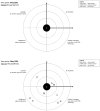COVID-19 and social distancing: pandemic has altered social relationships and contacts in older adults over 4 years
- PMID: 39737450
- PMCID: PMC11683058
- DOI: 10.3389/fpubh.2024.1456829
COVID-19 and social distancing: pandemic has altered social relationships and contacts in older adults over 4 years
Abstract
Introduction: Social isolation is a main risk factor for loneliness, health issues and psychological diseases. With its restriction measures, the coronavirus pandemic has led to an objective reduction in meaningful interactions, communication, and social contacts in general (social isolation). However, it has been shown that older adults cope differently with social isolation. Therefore, the aim of the present study was to investigate the changes of social contacts of older adults over the pandemic period of 4 years.
Methods: For this purpose, N = 175 older adults (M age = 72.60, SD age = 6.12 years, Mdn age = 72, Range: 60-87 years) were asked at 3 time points (2019, 2021, 2023) with how many people they had contact in the reference month (May, November). In addition to the number of contacts, participants were also asked about the type of the relationship (e.g., family, friends, neighbors), the type of contact (e.g., telephone, video conference and/or by written messages) and the emotional closeness (close, medium, low). We used an ego-centered "social network" circle to measure social contacts of older adults before, during and after the pandemic. The data collection was limited by the changing corona restrictions.
Results: Results indicate that behavior in social contacts essentially depends on age, gender, and level of depression. We found a clear temporal drop in social contacts independently of age and gender during the pandemic. After the pandemic close contacts did not recover to prepandemic level. Especially, Young-Old (<72 years) recovered less in terms of the number of social contacts than the Old-Old (≥72 years).
Discussion: Our study, thus, provides longitudinal insights into the course of social contacts and suggests that social isolation may have more negative and long-term impact on close contacts, which need further clarification and temporal extension.
Keywords: COVID-19; loneliness; older adults; social contact; social networks.
Copyright © 2024 Kastner, Suenkel, von Thaler, Eschweiler, Dankowski, Mychajliw, Brockmann, Heinzel and Thiel.
Conflict of interest statement
The authors declare that the research was conducted in the absence of any commercial or financial relationships that could be construed as a potential conflict of interest.
Figures


Similar articles
-
Video calls for reducing social isolation and loneliness in older people: a rapid review.Cochrane Database Syst Rev. 2020 May 21;5(5):CD013632. doi: 10.1002/14651858.CD013632. Cochrane Database Syst Rev. 2020. PMID: 32441330 Free PMC article.
-
The impact of COVID-19 restriction measures on loneliness among older adults in Austria.Eur J Public Health. 2021 Feb 1;31(1):44-49. doi: 10.1093/eurpub/ckaa238. Eur J Public Health. 2021. PMID: 33338225 Free PMC article.
-
Physical distancing is related to fewer electronic and in-person contacts and to increased loneliness during the COVID-19 pandemic among older Europeans.Qual Life Res. 2022 Apr;31(4):1033-1042. doi: 10.1007/s11136-021-02949-4. Epub 2021 Aug 21. Qual Life Res. 2022. PMID: 34417963 Free PMC article.
-
Social Isolation and Loneliness Among San Francisco Bay Area Older Adults During the COVID-19 Shelter-in-Place Orders.J Am Geriatr Soc. 2021 Jan;69(1):20-29. doi: 10.1111/jgs.16865. Epub 2020 Oct 9. J Am Geriatr Soc. 2021. PMID: 32965024 Free PMC article.
-
Interventions to reduce social isolation and loneliness during COVID-19 physical distancing measures: A rapid systematic review.PLoS One. 2021 Feb 17;16(2):e0247139. doi: 10.1371/journal.pone.0247139. eCollection 2021. PLoS One. 2021. PMID: 33596273 Free PMC article.
References
-
- Albreht T. Challenges to global health emerging from the COVID-19 panddemci. Sustainability. (2023) 15:7633. 10.3390/su15097633 - DOI
-
- Takács J, Katona ZB, Ihász F. A large sample cross-sectional study on mental health challenges among adolescents and young adults during the COVID-19 pandemic at-risk group for loneliness and hopelessness during the COVID-19 pandemic. J Affect Disord. (2023) 325:770–7. 10.1016/j.jad.2023.01.067 - DOI - PMC - PubMed
MeSH terms
LinkOut - more resources
Full Text Sources
Medical

